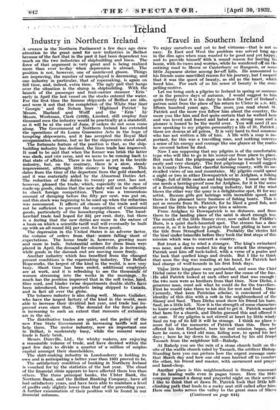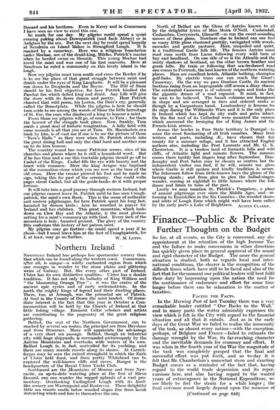Travel in .Southern Ireland
To enjoy ourselves and yet to feel virtuous—that is not so easy. In East and West the problem was solved long ago in the dim ages when Dian wanted to be good and yet happy, and to provide himself Width a sound' reason for tearing his home, with its tares and worries,-while he wandereffi off on tile enticing road to Mecca or Canterbury or Rangoon, or some little Japanese shrine among far-off hills. He announced to his friends some sanctified reason for hisjourney, but I suspect that it was the quest of beauty, as old as the heart, which lured him. For each of us his sense of beauty is the cone pelling motive. Let me bring-such a pilgrim to Ireland in spring or.sununer or in the pensive days of autumn. I would suggest to hilt' quite firmly that it is his duty to follow the feet of Ireland's patron saint from the place of his return to Ulster in A.D. 432, fifteen hundred years ago. The more, you read about St. Patrick and the more you follow him about the countrythe more you like him and feel quite nertain that he walked 'here and was loved and feared,and hated as a strong man and-a pioneer is bound-to be the world over. You will need (I am now speaking to my pilgrim personally) a life of St. Patrick ; there are dozens at, all prices. R_Sa very hard to find someone who has not written a life of him. A life with'a map is im- portant, for this was a travelling -man, and nothing conveys a sense of his energy and courage like one glance at the routes he covered before he died.
Now I am supposing that my pilgrim is of the comfortable type who will like to go in his motor-car from place to place. But mark that the pilgrimage could also be made by 'bicycle easily and very cheaply. The first pilgrimage I would suggest is in County Down, that cheerful farming county, with its un- rivalled views of sea and mountains. My pilgrim could spend
i
a night or two in either Downpatrick or in Ardglass, a fishing village, full of little castles and big herrings. I must say that one needs a herring-proof nose for Ardglass, for it is the scene of a 'flourishing flshmg and curing industry, but if the wind blows the other way the quay is a delightsome spot, fit for any artist. Buxom girls gut herrings with incredible speed, and there is the pleasant tarry business of fishing boats. This is not so remote from St Patrick, for he liked a good fish, and blessed the little boys who gave him a salmon.
From Ardglass to Downpatrick is no distance, and from there. to the landing place of the saint is short enough too. The mouth of the little Slaney river, now called the Puddler's Burn, is a quiet duck-haunted spot. The stream has a dam across it, so it is harder to picture the boat gliding in here on the tide from Strangford Lough. Probably the 'clerics hid ' the bOafunderffiranchts before they took the first steps of this mission which was to convert a country.
But trust a dog to wind a stranger. The king's swineherd was near, and down rushed his dog to attack the strangers, Patrick sent him off tuck-tailed, with a verse of a psalm and the look that quelled kings and druids. But I like to think that soon the dog was nuzzling at his hand, for Patrick had had charge of wolf-hounds in his first Irish days.
' These little kingdoms were patriarchal, and soon the Chief Dichil came to the place to see and hear the cause of the fuss. I He slid Patrick looked at each other and that was enough the two men were as brothers from that time. Now Dichu, fi generous man, must ask what he could do for the travellers. First he would take them to his dun for rest and food. Dean Carmody, that keen Patrician scholar, is convinced of the identity of -this-dun with a rath in the neighbourhood of the Slane), and Saul. Then Mani must show his friend his barn, ' Saul, on a little hill. Now it is the strength of some characters to know exactly what they want and to get it. Patrick wanted , that barn for a church, and Dichu guessed this and offered it at onee. If my pilgrim is not stirred at heart by little windy Saul on top of its hill it will be strange. I think no place is more full of the memories of Patrick than this. Here lie offered his first Eucharist, here his real mission began, and here he came, a tired old man, failing now, to spend his last days ; here he lay down to die, comforted by his old friend Tassach from the neighbour hill—Raholp.
At Raholp you see the ruin of a stone church built on the site of the wattle church ruled by Tassach, the artificer Bishop. Standing here you can picture how the urgent message came that March day and how one old man hurried off to comfort the other, his friend and master, with sacrament and prayer and hand-clasp.
Another place is this neighbourhood is Struell, renowned for its healing wells even in pagan times. Here the little company passed a damp and prayerful night on their arrival. I like to think that at dawn St. Patrick tocik that little hill- climbing path that leads to a rocky seat still called after him Here one looks across the valley to the great mass of Slim'U.
(Continued on rage 644)
Donard and his brethren. Even in Kerry and in Connemara I have seen no view to excel this one.
So much for one day. My pilgrim could-spend a -quiet evening poking about Downpatrick (and Inch Abbey) or in Ardglass by the sea. But the next day he could spend happily at Nendrum on Island Mahee in Strangford Lough. It is reached by a causeway. Here was a religious foundation under Mocbae, son of the druid-king, Milcho, Patrick's master when he herded swine on Slemish. This young Mochae had loved the saint and was one of his first converts. Here at Nendrurn he ruled a community on_this lovely island in the lough. Now my pilgrim must turn south and cross the Border if he is to see the place of that great struggle between saint and druids under the eyes of King Laoghaire. It will be a pleasant run down to Drogheda and the Boyne. The Hill of Slane should be his first objective, for here Patrick kindled the Paschal fire which defied king and druid. Any Life will give the story with its fierce drama and poetry. Here Patrick chanted that wildm, his Lorica, the Deer's cry, generally called the Breastplatepoe. While the pilgrim is here he should turn aside to see among the woods of Slane the little hermitage of St. Em, the man who disobeyed a king to honour a saint.
From Slane my pilgrim will go, of course, to Tara ; for there the fiercest of the struggle took place. Now, frankly, Tam needs a great deal of historic imagination. A hilly field with some mounds is all that you see at Tara. Dr. Macalasteir, ora book by him, is of vast use if one is to see the picture of those
Tam's Halls " as they were when St. Patrick strode into the great dining hall and only the chief bard and another rose up to do him honour. The country round has many Patrician scenes, sites of his churches and places where he is still a household word. But if he has time and a car this tractable pilgrim should go off to Cashel of the Kings. Cashel fills the eye with beauty and the heart with romance. Here the king Aengus was baptized at the coronation-stone which you see now as the base of the old cross. Here the crozier pierced his foot and he made no sign, taking this for part of the ceremony. One could write pages about Cashel, but all the guide-books do it with proper fervour.
It will take him a good journey through western Ireland, but our pilgrim cannot leave St. Patrick until he has seen Croagh- patrick, the saint's own Reek. This is the scene of authentic and austere pilgrimages, for here Patrick spent his long fast, haunted by demon birds ; here he wrestled in prayer for Ireland and her children. This great mountain, which looks down on Clew Bay and the Atlantic, is the most glorious setting for a saint's commurings with God. Every inch of the mountain is holy, haunted ground. The glory of the country fitly enshrines this history of her patron saint. My pilgrim may -go further—he could spend a year if he chose—but I must leave him at the foot of Croaghpatrick, for







































 Previous page
Previous page